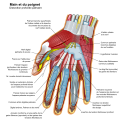Fil:Wrist and hand deeper palmar dissection-numbers.svg

Size of this PNG preview of this SVG file: 474 × 600 pixels. Andre opløsninger: 190 × 240 pixels | 379 × 480 pixels | 607 × 768 pixels | 809 × 1.024 pixels | 1.619 × 2.048 pixels | 555 × 702 pixels.
Fuld opløsning (SVG fil, basisstørrelse 555 × 702 pixels, filstørrelse: 207 KB)
Filhistorik
Klik på en dato/tid for at se filen som den så ud på det tidspunkt.
| Dato/tid | Miniaturebillede | Dimensioner | Bruger | Kommentar | |
|---|---|---|---|---|---|
| nuværende | 1. jun. 2015, 19:15 |  | 555 × 702 (207 KB) | Perhelion | optimize image |
| 8. jul. 2012, 13:42 |  | 555 × 702 (399 KB) | Wilfredor | optimize image | |
| 13. jan. 2009, 23:11 |  | 555 × 702 (817 KB) | Wilfredor | {{Information |Description= |Source= |Date= |Author= |Permission= |other_versions= }} | |
| 16. okt. 2008, 18:37 |  | 555 × 702 (815 KB) | Wilfredor | {{Information |Description= |Source= |Date= |Author= |Permission= |other_versions= }} | |
| 23. jul. 2008, 21:33 |  | 770 × 767 (822 KB) | Bibi Saint-Pol | {{Created with Inkscape}} == {{int:filedesc}} == {{Information |Description= {{en|The hands (med./lat.: manus, pl. manūs) are the two intricate, prehensile, multi-fingered body parts normally located at the end of each arm of a human or other primate. Th |
Filanvendelse
De følgende 2 sider bruger denne fil:
Global filanvendelse
Følgende andre wikier anvender denne fil:
- Anvendelser på af.wikipedia.org
- Anvendelser på ar.wikipedia.org
- Anvendelser på az.wikipedia.org
- Anvendelser på bjn.wikipedia.org
- Anvendelser på bn.wikipedia.org
- Anvendelser på br.wikipedia.org
- Anvendelser på ce.wikipedia.org
- Anvendelser på crh.wikipedia.org
- Anvendelser på cv.wikipedia.org
- Anvendelser på de.wikipedia.org
- Anvendelser på en.wikipedia.org
- Wikipedia:Featured picture candidates/Wrist and hand deeper palmar dissection-en.svg
- Wikipedia:Featured picture candidates/April-2009
- User:Madhero88/Medicalg
- Wikipedia:WikiProject Anatomy/Resources
- Wikipedia talk:WikiProject Anatomy/Archive 9
- User talk:Rhododendrites/Reconsidering FPC on the English Wikipedia
- Anvendelser på es.wikipedia.org
- Anvendelser på fa.wikipedia.org
- Anvendelser på fr.wikipedia.org
- Anvendelser på hr.wikipedia.org
- Anvendelser på hu.wikipedia.org
- Anvendelser på id.wikipedia.org
- Anvendelser på incubator.wikimedia.org
- Anvendelser på iu.wikipedia.org
- Anvendelser på ko.wikipedia.org
- Anvendelser på lbe.wikipedia.org
- Anvendelser på lb.wikipedia.org
- Anvendelser på lt.wikipedia.org
- Anvendelser på ms.wikipedia.org
- Anvendelser på nia.wiktionary.org
- Anvendelser på os.wikipedia.org
- Anvendelser på pl.wikipedia.org
- Anvendelser på pt.wikipedia.org
- Anvendelser på ru.wikipedia.org
- Anvendelser på ru.wikimedia.org
Vis flere globale anvendelser af denne fil.







